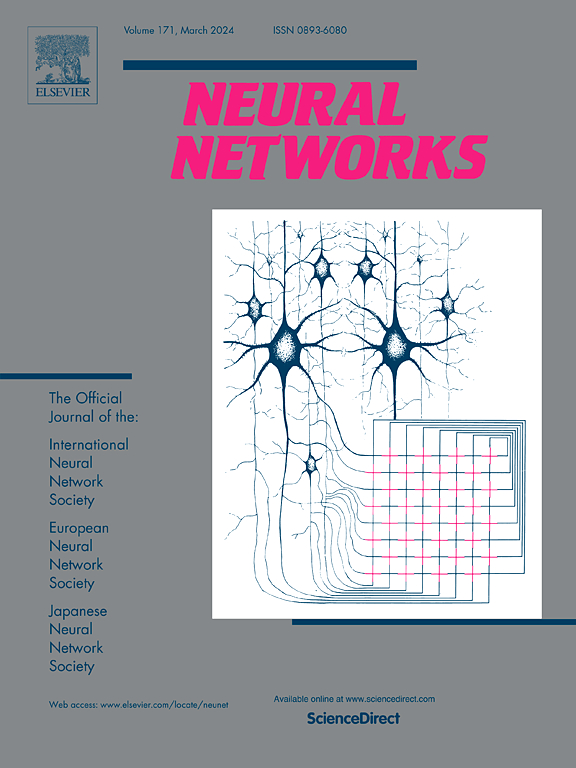修订:提高Hebbian卷积神经网络的生物学合理性和有效性
IF 6
1区 计算机科学
Q1 COMPUTER SCIENCE, ARTIFICIAL INTELLIGENCE
引用次数: 0
摘要
本文提出的研究将Hebbian学习集成到卷积神经网络(cnn)中进行图像处理,系统地探索不同的架构以构建最优配置,坚持生物可行性。Hebbian学习对局部无监督神经信息进行操作,形成特征表示,为流行的但生物学上不可信且计算密集型的反向传播学习算法提供了另一种选择。建议的最优架构显著增强了最近旨在将Hebbian学习与竞争机制和cnn相结合的研究,通过将硬赢家通吃(WTA)竞争、高斯横向抑制机制和Bienenstock-Cooper-Munro (BCM)学习规则结合在一个模型中,扩展了它们的表示能力。在CIFAR-10的后半个测试周期中,平均准确率分类测量结果显示,所得到的最优模型与端到端反向传播变体的匹配率分别为75.2%,大大超过了相同网络深度的cnn中最先进的硬wta性能(64.6%)10.6%。它在MNIST(98%)和STL-10(69.5%)上也取得了具有竞争力的表现。此外,研究结果表明,通过越来越复杂和抽象的接受域,稀疏的分层学习有明显的迹象。总之,我们的实现提高了学习表征的性能和可泛化性,并构成了迈向更生物逼真的人工神经网络的关键一步本文章由计算机程序翻译,如有差异,请以英文原文为准。
Revision: Advancing the biological plausibility and efficacy of Hebbian Convolutional Neural Networks
The research presented in this paper advances the integration of Hebbian learning into Convolutional Neural Networks (CNNs) for image processing, systematically exploring different architectures to build an optimal configuration, adhering to biological tenability. Hebbian learning operates on local unsupervised neural information to form feature representations, providing an alternative to the popular but arguably biologically implausible and computationally intensive backpropagation learning algorithm. The suggested optimal architecture significantly enhances recent research aimed at integrating Hebbian learning with competition mechanisms and CNNs, expanding their representational capabilities by incorporating hard Winner-Takes-All (WTA) competition, Gaussian lateral inhibition mechanisms and Bienenstock–Cooper–Munro (BCM) learning rule in a single model. Mean accuracy classification measures during the last half of test epochs on CIFAR-10 revealed that the resulting optimal model matched its end-to-end backpropagation variant with 75.2% each, critically surpassing the state-of-the-art hard-WTA performance in CNNs of the same network depth (64.6%) by 10.6%. It also achieved competitive performance on MNIST (98%) and STL-10 (69.5%). Moreover, results showed clear indications of sparse hierarchical learning through increasingly complex and abstract receptive fields. In summary, our implementation enhances both the performance and the generalisability of the learnt representations and constitutes a crucial step towards more biologically realistic artificial neural networks
求助全文
通过发布文献求助,成功后即可免费获取论文全文。
去求助
来源期刊

Neural Networks
工程技术-计算机:人工智能
CiteScore
13.90
自引率
7.70%
发文量
425
审稿时长
67 days
期刊介绍:
Neural Networks is a platform that aims to foster an international community of scholars and practitioners interested in neural networks, deep learning, and other approaches to artificial intelligence and machine learning. Our journal invites submissions covering various aspects of neural networks research, from computational neuroscience and cognitive modeling to mathematical analyses and engineering applications. By providing a forum for interdisciplinary discussions between biology and technology, we aim to encourage the development of biologically-inspired artificial intelligence.
 求助内容:
求助内容: 应助结果提醒方式:
应助结果提醒方式:


